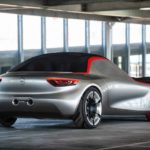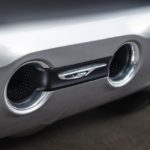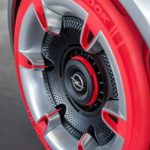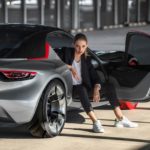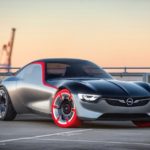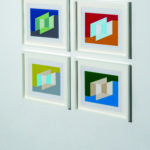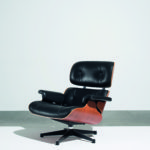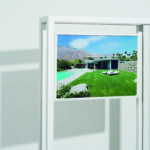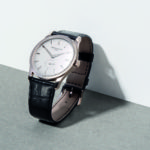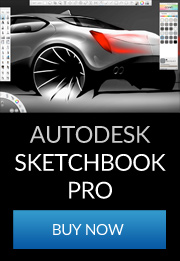Archives for :
Design
The Opel GT Concept will be unveiled to the World at the 86th Geneva International Motor Show (March 3 to 13, 2016). The GT Concept is a front mid-engine and rear-wheel drive is a direct descendant of the Opel GT and the Monza Concept and evolves Opel’s sculptural design philosophy. The car is very simplified and pure in form. The GT Concept has no door handles or exterior door mirrors.
“We are taking the next step towards even more emotion and driving pleasure with the Opel GT Concept. The GT Concept shows what Opel stands for now. We are confident, ambitious, innovative and we want win over more customers with every new car,†said Opel Group CEO Dr. Karl-Thomas Neumann who is already looking forward to the world premiere in Geneva.
- Avant-garde: The Opel Motoclub 500 motorbike from 1928.
The Opel GT Concept will follow in the footsteps of the famous Opel Experimental GT at the Geneva Motor Show. In 1965, only one year after the foundation of the first design studio run by a European car manufacturer, Opel presented this sleek and expressive coupé based on the technology of the Kadett B at the Frankfurt Motor Show. The GT incorporated innovations such as retracting headlamps and displayed a slim form along with perfect proportions without unnecessary decoration. The uncompromising concept by Erhard Schnell mainly wanted to be one thing – a design statement. The reactions from the public were so overwhelming that the series production Opel GT was at dealerships only three years later. The rest is history – a success story, an automotive icon.
The GT Concept incorporates a red signature line that splits the vehicle body horizontally. The distinctive red front tires – mounted on rims with a roller skate design – are reminiscent of the Opel motorbike Motoclub 500 that was also avant-garde at its time and was the proud owner of two red tires in 1928. Apart from that, the GT Concept does not have many links to the past. The long bonnet, the absence of a trunk lid, the central dual exhaust and of course, the name all refer to the original GT. Apart from that the Opel GT Concept is independent with no sign of retro-design.
“We created the GT Concept to capture the bold, emotional spirit of the Opel brand. It is dramatic, sculptural and full of innovations, which is our great tradition that we intend to continue. Back in 1965, Opel developed the Experimental GT, a thoroughly modern vehicle that also boasted a pure sculptural shape. It’s certainly difficult to reinvent an icon but just as the Experimental GT was avant-garde back then, so too is this GT Concept today – absolutely pure, minimalistic, yet bold and uncompromising. This coupé impressively demonstrates the continuous development of our Design philosophy – ‘Sculptural Artistry meets German precision’,†said Mark Adams, Vice President, Design Europe.
A key innovation of the Opel GT Concept are the large doors with the integrated side windows that show a seamless transition from glass to painted surfaces. Both the driver and the front passenger gain access to the unexpectedly spacious interior after pressing the touchpad for the electric doors that is integrated in the red signature line of the roof. Even tall drivers have enough room inside. The doors immerse considerably into the front wheel arches when opened. This space-saving and patented mounting allows a large opening angle – particularly in relatively tight parking spaces. The compact athlete is therefore optimized especially for urban areas. Two cameras mounted behind the wheel arches ensure a safe overview while driving in the city. They transmit their images to two monitors on the left and right-hand side of the cockpit – the days of exterior door mirrors and blind spots are therefore over. The windshield flows into a glass panorama roof enabling the occupants to enjoy a driving experience similar to that offered by a targa with a removable roof.
Power
The stretched bonnet reveals the powertrain concept of the GT Concept: Just like the first Opel GT and Corvette, also made by GM, it has a front mid-engine. The vehicle’s centre of gravity is therefore low and central – ideal for sporty handling and excellent cornering dynamics. The Opel GT Concept has a powerful 1.0-litre, three-cylinder turbocharged engine based on the ultra-modern all-aluminium engine used in ADAM, Corsa and Astra. The extremely efficient direct injection petrol unit develops 107 kW/145 hp and maximum torque of 205 Nm in its sporty trim (consumption values for the Opel GT Concept are not available yet). The turbo power is sent towards the rear axle with mechanical differential lock via a sequential six-speed transmission that is operated by shift paddles on the steering wheel. The low weight (below 1,000kg) allows the GT to accelerate from 0 to 100 km/h in less than eight seconds, with a top speed of 215 km/h.
A further highlight of the Opel GT Concept are the main headlamps with integrated indicators. Thanks to projection technology, these shine very three-dimensionally. The next generation adaptive full LED light is obviously the perfect match for this technology. The Opel IntelliLux LED® matrix light, which allows glare-free high beam driving, already made its debut in the new Astra in 2015 and won the SAFETYBEST Award. The Opel GT Concept sees the introduction of the next stage of development of the intelligent light system. The design of the lights is rounded off by the three-dimensional design of the tail lamps that make the new GT distinctive at night.
At Ford, ensuring materials and upholstery are up to the mark is crucial for everything from the first impression all the way down the line to the perception of the vehicle after considerable use – and thus resale value and reputation. We knew about Ikea’s kitchen drawer tests, now Ford are shedding a little light on their processes for testing and selecting fabrics and materials.
In short..
- Ford engineers scratch, snag and stretch all the different materials that go inside a vehicle to help ensure their durability and suitability to long-term customer use
- Fabrics that are used inside Ford vehicles are stained with everyday substances like hot coffee, soda and dirt to evaluate how well they can be cleaned afterward, testing their overall stain resistance
- A team of examiners smell various samples of materials used inside Ford vehicles and rank them to help the engineers achieve interiors with a perceptible but not disturbing odour
- Soiling and Cleanability Test — putting Ford’s interior materials to the ultimate stain test to help ensure accidental spills and smudges don’t ruin the car’s interior in the long run.
- Odor Test – All materials, leather or fabric used in Ford vehicles are put through this meticulous sniff test to help the engineers achieve interiors with a perceptible but not disturbing smell
- Five Finger Scratch Test – scratching samples of different plastics to see how strong, sturdy and as resilient are they to scratches
- Resistance to Dye Transfer Test – rubbing materials of different colors against the leather used for car seats to see if any stains are left behind.
- Mace Snagging Test – spinning seat fabrics on rotating rollers by spikey iron ball to test their strength.
- Soiling and Cleanability Test — splashing different substances on seat fabrics to evaluate how well they can be cleaned afterwards, testing their overall stain resistance
Throughout a vehicle’s lifetime, it’s inevitable that the materials inside a car show signs of wear and tear. Wear occurs in all contact areas from sitting on car seats, leaning on arm rests, gripping the steering wheel through to fiddling with the instruments.
So what does Ford do to ensure interiors will hold up?
To help guarantee the durability of these fabrics, leathers and plastics, Ford engineers subject every material used inside Ford vehicles to a series of meticulous and unrelenting tests where they are stretched, scratched, snagged, sniffed and even splashed with the likes of grease, dirt and hot coffee, to see how they will stand up against the test of time.
These tests are done to help ensure it takes a lot more than a spilled cup of coffee, the graze of a sharp edge or any accidental scrapes and scuffs to break down these materials. Some of the unusual ordeals Ford materials need to go through include:
- The Five-Finger Scratch Test, which is used to scratch samples of different plastics to see how much abuse they can take
- The Soil and ‘Cleanability’ Test, which splashes different substances on seat fabrics to evaluate how well they can be cleaned afterwards, testing their overall stain resistance
- The Resistance to Dye Transfer Test, which rubs materials of different colors (i.e. those dreaded new blue jeans, long-term destroyer of white leather sofas around the world) against the leather used for car seats to see if any stains are left behind
- The Mace Snagging Test, which spins seat fabrics on rotating rollers roughly 600 times while they’re repeatedly struck by a spikey iron ball to test how strong they are
In addition to the poking, prodding and scratching, a team of examiners smell various samples of materials used inside Ford vehicles and rank them to help the engineers achieve interiors that are free of disturbing odours.
The purpose of these tests is to create and maintain a level of quality in Ford vehicles that can be expected to last through the vast majority of scenarios of car usage for years to come.
Further watching..
Nissan put an exclamation point on the start of sales of its all-new 2016 TITAN XD by unveiling a super-sized, off-road modified design study it calls the TITAN Warrior Concept. Nissan Design America (NDA) took the TITAN XD’s production design to new extremes with unapologetic, aggressive, athletic styling features that declare the concept’s off-road adventure intent and Nissan’s optimism for the truck market.
“Truck buyers have a seemingly insatiable appetite for more content and more unique offerings,†said José Muñoz, executive vice president, Nissan Motor Co., Ltd. and chairman, Nissan North America, Inc. “Even though our all-new 2016 TITAN XD just started arriving at Nissan dealers nationwide last month, we are already exploring new territory where TITAN might go in the future.â€
Pushing the Boundaries
Just as the all-new TITAN XD with its Cummins® 5.0L V8 Turbo Diesel engine has bulked up the standards for customers shopping the light-duty pickup class, the TITAN Warrior Concept was created to take the production version to the extreme.
“Nissan has always pushed the boundaries of traditional automotive design and engineering, from our Nissan GT-R supercar to the new TITAN XD,†explained Muñoz. “We do this with a clear conviction that there are buyers out there who appreciate something everyone else does not have. A `work hard, play harder, get bigger’ TITAN XD certainly does the job.â€
The TITAN Warrior Concept builds on the recent Project Titan, a crowd-sourced customization of an original-generation Titan that sent two U.S. military veterans representing Wounded Warrior Project® on a once-in-a-lifetime adventure in Alaska. The new concept truck also pays homage to Nissan’s heritage of off-road racing and adventuring, which goes back to the days of Baja “Hardbody†competition pickups and Paris-Dakar Rally treks.
“As we launch the all-new 2016 TITAN XD, the TITAN Warrior Concept was conceived to share our team’s pride and excitement to be back in the truck market in a big way,†added Muñoz. “The team delivered.â€
A Warrior with a “Modern Armor†Exterior
The TITAN Warrior Concept creators had more than a strong foundation on which to build their vision of a bold and expanding future in the full-size pickup market, they had a familiar one.
As part of the group that brought the “American TITAN†to life – a group that ranged from Tennessee, Michigan, Mississippi, Indiana, Arizona and California – the design team imagined how their original TITAN design, inspired by warriors in ancient Greek mythology, might evolve to extreme levels of adventure duty.
First, while maintaining the TITAN XD Crew Cab’s standard wheelbase and length, they wanted to give the concept truck an even more powerful presence than the original. The height was raised nearly three inches, from 78.7 inches to 81.5 inches, to fit a quartet of 37-inch tall off-road tires mounted on custom 18×9.5-inch aluminum-alloy wheels. The wheels’ machined aluminum surfaces feature a dark matte finish and continue the production TITAN XD’s “precision tool†design theme.
To create clearance for the new oversize tires and accommodate the new, long-travel suspension, the TITAN Warrior Concept’s width was extended three inches on each side, from 80.6 inches total to 86.6 inches. Once the dimensions and imposing stance were mapped out, the extreme makeover began in earnest.
Building on the new second-generation TITAN’s warrior-inspired styling, the designers amplified the protective look of the production exterior. Designating the new look as “modern armor†– with a stealthy, robotic quality – they continued the anatomical feel of the production TITAN, but added a more machine-like, sharper-edge appearance.
The grille and signature TITAN headlights were enhanced to offer a more technical, menacing look. The front and rear fenders have been flared and offer an extremely muscular appearance. Functional hood vents were added for cooling the powerful diesel engine. The broad hoodline is balanced underneath by the large front skidplate, which interlocks into the powerful front bumper.
Custom LED lights, front and rear, add to the TITAN Warrior Concept’s stealthy presence. The headlights carry a sense of the new Nissan signature boomerang lights, but with a more precise, upright, robotic feel. In the rear, the integrated LED taillights take the form of a TITAN “T†logo, split by the wide tailgate. As a finishing touch, a quad-tipped exhaust system is integrated into the rear bumper.
Despite its massive bulk, TITAN Warrior Concept adds several aerodynamic elements, including carbon fiber rear cab spoiler and tailgate spoilers. Additional unique body elements include integrated, roof-mounted LED off-road lights.
The TITAN Warrior Concept is covered in a custom matte-gunmetal paint called “Thunder†and accented in special “Magma†orange and black color highlights.
“There’s a sense to the exterior design that the TITAN Warrior Concept could drive right off the auto show stage and retrace the historic route of Nissan’s off-road racing victories in the Baja Peninsula,†said Muñoz. “And given the high-torque Cummins 5.0L V8 Turbo Diesel, extensive suspension modifications and TITAN XD heavy-duty durability, it certainly could.â€
A Polished, Premium Sport Interior
Inside the TITAN Warrior Concept’s rugged performance-focused exterior is an interior conceived to handle the abuse experienced on an extended off-road excursion in comfort and style.
“Today’s truck enthusiasts don’t just use their trucks for weekend adventures, they do double-duty as daily drivers,†explained Muñoz. “Therefore the TITAN Warrior Concept’s interior reflects a premium outdoor lifestyle, closer in look and content to a new TITAN XD Platinum Reserve model than a stripped-down pre-runner.â€
The interior design team at Nissan Design America wanted to give the vehicle a unique polished “chronograph†look and feel, focusing on materials and detailing while remaining true to the TITAN Warrior Concept’s active performance theme. For example, the seats are covered in a carbon-colored high-strength seat fabric trimmed with “Magma†orange accents. Interior surfaces utilize material, such as carbon fiber, polished chrome finishes, leather with accented Magma orange stitching.
The TITAN Warrior Concept’s steering wheel is custom-built, continuing the technical adventure theme, milled from one block of aluminum. Other interior details include unique hot-and-cold drink containers integrated into the center console. Robust auxiliary toggle switches are integrated into the center stack for additional off-road accessories. Instrument panel-mounted auxiliary gauges are provided to easily monitor truck performance.
Performance Unleashed
As an extreme adventure version of the new 2016 TITAN XD, the TITAN Warrior Concept utilizes the factory fully boxed ladder frame and Cummins® 5.0L V8 Turbo Diesel engine and the standard heavy-duty 6-speed Aisin automatic transmission as its base.
Where the TITAN Warrior Concept departs from its production counterpart is in the full custom suspension design. In the front, the standard suspension has been replaced with custom upper and lower control arm with performance ball joints, along with racing-style internal bypass reservoir coil-over shocks with custom reservoir mounts and tie-rod extensions.
In the rear, the modifications include custom internal bypass reservoir shocks with custom reservoir mounts. Adjusted-length prototype axles were installed, along with a custom sway bar, relocated sway bar brackets and rear lift blocks and U-bolts. Hydraulic pressurized bump stops were also added front and rear.
Exploring New Boundaries
The debut of the TITAN Warrior Concept at the North American International Auto Show comes exactly one year since the debut of the production TITAN XD on the same stage. TITAN XD has been named “Truck of Texas†by the Texas Auto Writers Association (TAWA) in their annual Texas Truck Rodeo, which puts the industry’s best trucks, SUVs and CUVs through a grueling two-day evaluation. In addition to the competition’s top award, Truck of Texas, the TITAN XD won three other honors – Luxury Pickup Truck of Texas, Off-Road Pickup Truck of Texas and Best Powertrain for its standard Cummins® 5.0L V8 Turbo Diesel engine.
Now that TITAN XD Crew Cab with a Cummins 5.0L V8 Turbo Diesel engine is in Nissan showrooms, the rollout of new models continues. In December, Nissan announced that advanced gas-powered Endurance® V8 producing 390 horsepower and 401 lb-ft of torque will be available in both TITAN and TITAN XD models beginning in early spring 2016.
Ultimately, the new TITAN will be offered in three cab configurations, two frame sizes, three powertrain offerings and five grade levels (more information on the full lineup will be available at a later date).
“While Nissan still has many roads and trails to travel as we continue to launch additional production versions of our bold new TITAN, this new TITAN Warrior Concept gives an important signal to American truck enthusiasts that our vision for exploring new boundaries remains strong,†concluded Muñoz. “Truck lovers are never static and neither is TITAN.â€
“The world would be a sad place for me, without great design†–
Gerry McGovern.
Modern automotive design is, by necessity, high-tech and computer-led – leading to the belief that the human touch has largely been lost. But it is no coincidence that the imaginative mind behind one of the most successful car marques in existence takes influence from beyond the computer screen in order to design cars that provoke thought, interest, emotion and affection.
The Range Rover is just such a car. Launched in its original guise in 1970, it truly deserves to be called a ‘design icon’ – a status it has achieved through four model generations, the latest of which has even been hailed as ‘possibly the best car ever made’.
And now, as Range Rover celebrates its 45th anniversary, Land Rover’s Design Director and Chief Creative Officer Gerry McGovern gives an insight into five objects that have inspired and influenced the way in which he approaches his work.
1. Round Café, Coventry
This cylindrical café, which opened in the late 1950s, was a symbol of the modernist design philosophy introduced by Coventry town planner Donald Gibson, and has been regarded as a city centre landmark ever since.
The building, like many built in Coventry at the time, stood as a symbol of post-war optimism. Gerry says: “During the 1960s, the whole city centre was really modern, with mosaic tiling and large expanses of glass – most of the buildings in the town centre were forward thinking.
“My mother worked in the café for a while and I used to sit in there as a child. It felt like being in a spaceship. So I was introduced to this world of modernism and futuring from a very young age, which is something that has always stayed with me.â€
2. Eames lounge chair
The iconic Eames Lounge Chair was designed by Charles and Ray Eames for the Herman Miller furniture company in 1956. The chair’s unique shape, exposed structure and base materials of molded plywood and leather is said to be inspired by a baseball mitt.
The Eames chair has been a design favourite of Gerry’s for many years, representing a timeless piece that has both utility and purpose at its core. Gerry says: “It is perhaps an obvious choice for a designer to make, however it’s so good and continues to give me pleasure, which is what ultimately all good design should have the ability to do. For me, it’s a piece of design that is still relevant today.
“The Eames chair has certain values that are important to me as a designer. For example, being true to materials. The fact that, rather than covering up the structure, the designers chose to celebrate it. However, by continually refining and updating the materials and finishes, as well as improving the quality of construction with more contemporary materials, softer leathers and lighter woods, means that it’s still as relevant today as the day it was designed.â€
3. Josef Albers – ‘Never Before I’ series
German-born Josef Albers was an artist and teacher who specialised in painting, printmaking, murals and architecture. After emigrating to America in the 1930s, Albers was regarded as an important influence on generations of younger artists and was credited as an innovator in the fields of Op art and Colour Field painting.
The clarity and precision of Alber’s work is of particular significance to Gerry, he says: “Albers is recognised as one of the world’s greatest modernist printmakers. To me, the beauty lies in the precision of each colour against the other. There is absolute clarity in his work.
“One of the reasons why I admire Albers so much is the precision that he achieved through silkscreen printing, which meant he could create perfect lines of connecting colour. The colours are so vibrant, so rich. I never tire of his work – I bought my first collection by Albers more than 15 years ago and while I’ve sold many other artists work over the years, I’ve always kept the Albers.
“When creating an initial vehicle design, you start with the fundamentals, which are optimized volume and proportions and followed on by surfacing and detail. There is a sense of graphic design and symbolism in a lot of my favourite art, Albers’ printmaking is a perfect example.â€
4. Kaufmann Desert House, Palm Springs, California
Designed by Richard Neutra in 1946, the Kaufmann House is located in Palm Springs, California. It was created for the businessman and philanthropist Edgar Kaufmann and was purposefully designed to sit in juxtaposition with the surrounding mountains. It is seen as a prime example of modernist architecture.
The design aesthetic particularly resonated with Gerry, he says: “The Kaufmann House has that sense of bringing the outside in, which is something that we deliberately tried to incorporate with the inclusion of the panoramic roof on our Range Rovers.
“Many of our customers are being chauffeured through cities and want to look up and be able to take in their surroundings. We felt that it was important to introduce the large glass roof so we could bring a sense of the environment into the vehicle and thus create a sense of occasion.â€
5. Patek Philippe Calatrava watch
Since 1851, Patek Philippe has produced some of the world’s greatest timepieces and its unpretentious, yet sophisticated designs have been a mainstay throughout its history. Gerry owns two examples of the Swiss ultra-luxury watch manufacturer’s work – the Nautilus and Calatrava. He says: “The Calatrava particularly represents, in my view, a masterclass in simplicity and sophistication. It’s as much about what it doesn’t say, as what it does say. It’s a beautiful thing – the notion of ‘less is more’ is a fundamental part of its design philosophy. Every detail on the watch is doing a job.â€
Gerry concludes: “All five of these objects have the ability to connect on an emotional level. For me, emotional design has three key components. The first is visceral – when you look at it do you desire it. The second is behavioral – when you use it does it do what it’s meant to do. And finally, reflective – once you have experienced it, does it continue to excite. To me, Range Rover epitomizes all three of these components.â€
Gerry McGovern is Design Director and Chief Creative Officer for Land Rover. After completing a degree in industrial design at Coventry University, McGovern studied for a Masters at the Royal College of Art in London, specialising in automotive design. His early career took in stints at Chrysler, Peugeot and Rover Group, where he was lead designer of the critically acclaimed MGF sports car, Land Rover Freelander and third generation Range Rover.
After a spell at Ford Motor Company heading up Lincoln-Mercury, McGovern returned to the UK to run a design consultancy in London before rejoining Land Rover in 2004 as Director, Advanced Design. He was appointed Land Rover Design Director in 2006 and his position has since grown to include the role of Chief Creative Officer and he is an Executive member of the Jaguar Land Rover Board.
Today, Hyundai débuted its N 2025 Vision Gran Turismo Concept for the North American market at the Los Angeles Auto Show. This concept demonstrates the Hyundai brand’s unique perspective on future performance characteristics and was developed as one of the latest additions to the Vision Gran Turismo. The Vision Gran Turismo project invites automakers, design houses and leading brands to design special concept vehicles that showcase the future of automotive design, exclusively for Gran Turismo®, one of the most popular video game franchises. The N 2025 Vision Gran Turismo boasts a hydrogen fuel cell powertrain capable of generating an impressive 884 PS (872 HP), using an additional super capacitor system.
- Concept named overall winner in transportation category
- Design award recognises ‘perfect combination of aesthetics and precision’
- EXP 10 Speed 6 is a statement in modern British luxury and a potential future model line
- Flying Spur and Continental GT Speed both receive special mentions
- Bentley Continental GT Photo: James Lipman / jameslipman.com
Bentley’s EXP 10 Speed 6 concept car has been awarded Gold in the Transportation category of the German Design Awards – one of the most highly respected design competitions in the world.
The German Design Council selects a panel of international design experts to judge the entries. They selected the EXP 10 Speed 6 for the Gold award as a result of its timeless, iconic Bentley design, clever use of new materials and aesthetic dynamism.
Panel judge, Johannes Barckmann, commented: “The designers of the EXP 10 Speed 6 achieved a fantastic reinterpretation of the British legend. This is particularly apparent when looking at the interior. The door panels are not covered with leather, but instead with high-quality wood.
“The exterior inspires with a progressive, elegant design vocabulary that transports the classic car into the future. EXP 10 Speed 6 is an extraordinarily beautiful automobile that perfectly combines aesthetics and precision – and is unmistakably a Bentley. It couldn’t be done better.â€
The EXP 10 Speed 6 is a British interpretation of a high-performance two-seater sportscar. It showcases the future direction of luxury and performance using the finest materials and advanced hybrid technology – a powerful, exquisite and individual concept.
Sangyup Lee, Head of Exterior and Advanced Design at Bentley, added: “EXP 10 Speed 6 dominated the conversation at Geneva earlier this year, and is one of the most talked about concept cars of recent times. Our progressive and innovative design – while retaining a classic British look – is also thoroughly modern and dynamic.â€
The Bentley Flying Spur and Continental GT Speed – both refreshed in 2015 with a complement of new interior features and exterior styling cues – also received special mentions from the German Design Awards judging panels.
- Jaguar Land Rover voted winners of three categories by readers of Germany’s leading motoring magazine Auto Motor und Sport
- Jaguar XF and XE top upper middle class and middle class categories
- Range Rover Evoque wins SUV class by huge margin
- Jaguar voted runner up in design brand of the year category
Jaguar Land Rover has been honoured with three trophies at the prestigious Autonis design awards, voted for by readers of Germany’s leading motoring magazine, Auto Motor und Sport.
In the 15th annual reader survey, 115 cars competed across ten categories with more than 17,500 votes cast. The Jaguar XF led the upper middle class category with 42 per cent share of votes, beating local competition from the Audi A6 (35 per cent) and BMW 7-series (30.5 per cent).
The all-new Jaguar XE scooped 36 percent of votes in the middle class group, relegating the Mercedes C-Class and BMW 3-series to second and third place with 29 and 28 per cent of the votes respectively. Jaguar also took home the silver medal in the design brand of the year class.
Land Rover celebrated success in the SUV class with the Range Rover Evoque winning by the biggest margin of all award entrants, receiving almost twice as many votes (45 per cent) than its closest rivals the Audi Q3 (23 per cent) and the BMW X1 (23 per cent).
Speaking at the awards, Adam Hatton said: “Having the XE and XF voted most attractive car by Auto Motor Und Sport readers is testament to the design philosophy and brand values of Jaguar. By accepting this award I’d like to thank the fantastic design team who I am privileged to work with every day who have incorporated aerodynamic design and aluminium materials to create the lightest, stiffest, most dynamic and most attractive Jaguars yet.â€
- With the addition of many tech and convenience features, the all-new Ford Mustang steering wheel is now the most advanced in pony car history
- The all-new Mustang steering wheel is the most advanced ever – the addition of new technical features follow a long line of innovations
- Mustang steering wheel has undergone many styling changes since its debut in 1964
When Mustang first debuted in 1964 it singlehandedly defined the Pony Car segment and has been setting the standard for design ever since. It has influenced trends in every aspect of vehicle styling including the steering wheel. The all-new Mustang carries on that leadership trend. From bare aluminum and resin, to Alcantara-wrapped with drive-mode and steering-effort control, Ford is reinventing the wheel.
1964: The first-generation Mustang was a worldwide sensation. An original design America couldn’t get enough of, it established the classic long nose, tight cabin, abrupt trunk proportion stance, which has become Mustang’s signature look. The Mustang interior had its own appeal, with a twin cockpit layout and what would become an iconic steering wheel with three bare-aluminum spokes and a simulated wood rim with a center horn ring. The wheel’s large 16-inch diameter allowed for easy turning, as power steering was optional equipment.
1967: As Mustang matured, new features were added to make it more functional and more convenient for enthusiast buyers. A tilt-away wheel with seven adjustments was available. This allowed drivers to choose the steering position that fit their preference, while also improving vehicle entry and exit without sacrificing looks or practicality. A new faster ratio (20.3:1) power steering system became available in 1967, making turn-in quicker for a sportier feel.
1968: Safety became a priority, and a collapsible steering column was added to Mustang to aid in reducing the possibility of injury in a crash. To bolster this feature, the redesigned two-spoke steering wheel featured a larger, cushioned center section. The center hub horn control was replaced with the small, metal half-circle on the bottom half.
1974: With the launch of the all-new second-generation Mustang II, design took a new, contemporary direction. The three-spoke wheel was replaced with a leather-wrapped two-spoke wheel. Mustang II introduced available power rack-and-pinion steering – allowing cars equipped with that feature to have a smaller 15-inch wheel as opposed to the standard 16-inch one.
1979: With introduction of the much-loved Fox Body Mustang, more European design language was adopted inside and out. The two-spoke wheel from Mustang II was replaced with a four-spoke wheel, which was later shared with other Ford products. Wiper and light controls moved to a steering column stalk. The Fox Mustang steering wheel was a harbinger, incorporating vehicle controls for the first time. Cruise control was offered on manual transmission-equipped cars, with the feature controlled by buttons on the steering wheel.
1984: Mustang was developed into a high-performance variant with the legendary Special Vehicle Operations Mustang. In addition to the high-output turbocharged four-cylinder engine, SVO Mustang’s performance upgrades included an aggressive tilting three-spoke steering wheel featuring a thicker rim and smaller outside diameter for a sportier look and feel. The Ford logo and “SVO†are embossed into the leather on the center of the wheel.
1990: Mustang received its first airbag as standard equipment. Because the airbag was located in the center of the steering wheel, the horn was moved from the center to two spoke-mounted buttons, easily accessible by the natural position of the driver’s thumbs. Cruise control buttons were also placed in a more ergonomic position.
1994: The launch of the fourth-generation Mustang included a nod to the original 1964 pony car, with a twin cockpit layout and sculpted modern styling for the steering wheel and airbag. Various buttons became easier to use, while allowing for the driver to keep eyes on the road and hands on the wheel. Horn buttons were replaced with a hinged airbag cover, acting as horn control at the wheel’s center.
2005: Based on the 1965-1967 Mustang design, this three-spoke wheel appeared on the fifth-generation Mustang. This wheel was available with standard urethane spokes, or optional aluminum spokes with the interior upgrade package. Unlike the steering wheels it was based on, this rim came wrapped in leather.
2010: Many buttons were added for SYNC voice control technology, including volume, phone, audio input selections and track/station selectors. The center badge changed from over-molded acrylic to high-quality spun aluminum with a polished aluminum horse, or snake in the case of Shelby GT500. Aluminum spokes hooking into the leather mimicked design elements of the center stack to impart a universal theme throughout the cabin. Contrast stitching in the steering wheel was available with the interior upgrade package.
2013: In further refinement of the Mustang steering wheel as the in-car tech control center, the wheel was revised to include a four-way control button, plus an “OK†button for instrument cluster screen control. Boss 302 and Shelby GT500 Mustangs got a race-inspired Alcantara-wrapped steering wheel.
2015: A totally redesigned steering wheel for the all-new 50th anniversary Mustang incorporates more controls than ever. Up to 20 buttons can be found on the wheel of the sixth-generation pony car, controlling everything from adaptive cruise control to SYNC functionality. Buttons on the right side of the wheel control SYNC and the radio, while buttons on the left deal with the driving controls and gauge cluster screen. Paddle shifters are available with automatic transmission-equipped Mustang for the first time – mounted on the rear of the steering wheel. The circle airbag in this wheel had to be specially designed to keep with Mustang heritage, as it’s the only steering wheel in Ford’s lineup with a circle airbag. It is also the company’s smallest diameter wheel, at just 14 inches. The aluminum spokes are trimmed back from the rim so the driver’s hands only touch leather when holding the wheel.
GT350: The Shelby GT350 and GT350R Mustangs represent the most track-capable street-legal Mustangs to date, and feature a race-inspired flat-bottom steering wheel with additional driver controls. Shelby drivers can make myriad adjustments to the car without taking their hands from the wheel. Wheel-adjustable features include electric power steering effort, MagneRide suspension settings, advanced drive mode selections and exhaust tuning. As with race car steering wheels, the rim is wrapped in Alcantara, and GT350R includes a stripe on the center at the top, which is designed to let the driver know when the wheel is at true center. For Shelby Cobra, the logo appears on the center of the wheel – the only place inside the car where the logo can be found. Spokes are finished in a darker hue than on Mustang GT – complementing the aggressive nature of Shelby Mustang.
- Ian Callum joins Scottish Motoring Hall of Fame
- Inaugural year also honours Sir Jackie Stewart and Jim Clark
- Presented by Association of Scottish Motoring Writers
Jaguar Director of Design Ian Callum has been named among the first inductees to the Scottish Motoring Hall of Fame at a prestigious ceremony held aboard the Royal Yacht Britannia and hosted by His Royal Highness Prince Michael of Kent.
The Association of Scottish Motoring Writers’ Scottish Motoring Hall of Fame, presented by Bridge of Weir Leather Company, was inaugurated as part of the opening celebrations of the Concours of Elegance, which opens at the Palace of Holyroodhouse in Edinburgh this weekend. Ian Callum joins motorsport legends Sir Jackie Stewart and Jim Clark as the first inductees.
Ian Callum said: “It’s a great honour, made even greater by the company I am in as an inaugural member of the Scottish Motoring Hall of Fame alongside Sir Jackie Stewart and Jim Clark. I am absolutely thrilled, and so proud.â€
Ian Callum, 61, was born in Dumfries, Scotland, and became Jaguar’s Director of Design in 1999, following a series of high profile design roles in the automotive industry.
Aged 14, Callum penned his first attempt at a Jaguar car design, and sent it to the company in the hope of landing a job. He went on to study industrial design and graduated from the Glasgow School of Art, and subsequently from the Royal College of Art in London with a postgraduate Masters degree in vehicle design.
President of the Association of Scottish Motoring Writers, Alisdair Suttie, commenting on his presentation to Ian Callum, said: “There is a very strong contingent of Scots in the world automotive sector, in both racing and industry, some of whom have been absolutely fundamental in putting Scotland on the map when it comes to globally significant achievements on wheels. These are the people that the Scottish Motoring Hall of Fame was created to celebrate, and Ian Callum, was right up there at the top of our list of such individuals. From his early design work, through to the Jaguars we know and love today – XK, XJ, XF, C-X75, XE, F-TYPE, F-PACE – his creations are heralded as pieces of automotive art the world over. I am very proud to induct Ian into the Scottish Motoring Hall of Fame.â€
The long and glorious passion story between Renault and the French can be told through advertising. By reflecting ̶ and sometimes anticipating ̶ social change, Renault adverts turn an amused and understanding eye on France and the lives of French people, mirroring their individual and collective unconscious.
1898: Advertising to promote the company name
Renault’s first advert was a real challenge: Louis Renault drove up the steep slope of rue Lepic in Montmartre Paris, with his Voiturette Type A. He was the first to achieve this feat, which won him his first orders. The company used motorsports as a way to promote its name. Renault won many city-to-city races, making a name for itself in both France and Europe. In the early 20th century, the adverts used by the company, which was first named “Renault Frères†and then just “Renaultâ€, were a reflection of their times, with thick, elaborate lettering and drawings of cars to emphasize speed and aerodynamics. The adverts sought to showcase French prestige, expertise and the other major field of progress of the time: aviation. Renault linked its image with that of the pioneering aviator, Hélène Boucher.
To welcome its customers in style, Renault displayed its products on the Avenue des Champs-Elysées in Paris from 1910, one of the first vehicle manufacturers to do so. With this showroom at the heart of the French capital, the brand was able to showcase its range on the premises occupied today by l’Atelier Renault. In the Edwardian era and between the two world wars, Renault sold luxury cars, relying on its reputation and its name to attract new customers. Brand identity was nurtured by the reflected glory of the FT17 tank, which played a decisive role in the first world war, and expressed in the form of the so-called “alligator†bonnets. The first logo appeared only in 1923, with the brand adopting the diamond shape in 1925. In 1934, Renault adopted an advertising slogan that would remain famous, even after 1944: “L’Automobile de Franceâ€. The brand naturally associated itself with France. Today, for French people, Renault remains France’s leading company, as indicated by the latest survey from the Viavoice Institute.
1946: Advertising during the post-war boom
After the Liberation, Renault contributed to the rebuilding of France with a range of cars, commercial vehicles and buses suited to all types of use. Renault was now a state-owned company tasked with building popular, affordable cars. In 1946, it launched the 4CV, a car that marked the start of the post-war boom years. At the same time, cars became more affordable, reflecting a new sense of freedom. With the 4CV, celebrated in the well known poster by illustrator Raymond Savignac, the French could enjoy their paid holiday leave and head for the sun via the Nationale 7 road immortalized in a song by Charles Trenet.
French society underwent many changes in the post-war years, including the baby boom, the development of city suburbs and the women’s liberation movement. All these changes brought the brand new customers. The workforce also gained new social rights. Renault was the first company to offer a third week of paid holiday (1955), followed by a fourth (1962) before this became law.
In 1963, Renault signed a partnership with Publicis for advertising communications. That same year, the dealership on the Champs-Elysées became the “Pub Renaultâ€, a warm and friendly place tasked with showcasing the brand. Advertising now used photographs to present the cars, rather than drawings. The long-serving Renault 4 kept pace with all these changes: the first campaign in 1961 highlighted its fuel economy, while the 1963 version celebrated the more feminine spirit of the “Parisienne†version. A decade later, Michel Fugain sang, “fais un tour en Renault 4, demande-lui beaucoup !†(“go for a drive in the Renault 4 and expect it to deliver the maximumâ€). In the 1980s, the Renault 4 became a car for young people and also for shopping malls, with the slogan, “Elle supermarche bienâ€, a play on “bien marcher†(to work well) and “supermarché†(supermarket). In this way, Renault advertising for the 4L accompanied the French public during thirty years of social change.
1972: Advertising in a time of crisis
The Renault 5 was an offbeat vehicle. Designed from its launch in 1972 for young people keen to break with the past: it was very much a product of the May 1968 demonstrations. The Renault 5 played on its bright colours to get itself noticed and this was reflected in the advertising, which focused on the car’s friendly, appealing looks and replaced the headlamps with big blue eyes. The “5†became a character in its own right, presented on TV in a joyous brightly coloured comic strip with a mischievous tone: “I am the Renault 5. In the city and on the road, they call me Supercarâ€. Following the oil shock, however, its other main advantage became the fuel economy of the GTL version (4.5l / 100 km). The Renault 5 became an anti-crisis vehicle expressing the social transition: its synthetic bumpers made it ideal for urban driving and awkward parking. At the same time, the customer base became younger (25% of owners under 30 at the moment of purchase) with a larger proportion of women (31%).
In the 1970s, the Renault line-up included a vehicle for every budget, from the city car (Renault 4 and 5) to the executive saloon (Renault 16) via a vehicle for the mid-range budget (Renault 6), alongside LCVs, trucks and tractors. With a range designed to meet every need, the brand played a real social role in the marketing of products tailored to all.
In the 1970s/1980s, Renault opted for innovation in the shape of the turbocharger. Based on a patent filed by Louis Renault in 1902, this development made its debut in endurance racing at the Le Mans 24-hour event and then on the Formula 1 track, where Renault vehicles proudly sported yellow, the brand’s emblematic colour. With the success of these vehicles, Renault transferred this technology to the road, particularly with the 5 Turbo. This constant quest for speed was echoed in TV advertising campaigns, with the Renault 9 and 11 putting on a burst of speed to save a truck with failed brakes, and the Renault 21 Turbo being chased down a German motorway by the Polizei, who stop the driver before letting him go.
1984: Renault, cars for living
Des voitures à vivre (cars for living) is the emblematic Renault slogan from the 1980s and the one that best reflects the brand’s thinking across the decades. The slogan was developed by Publicis and launched with the “Tranches de vie†(slices of life) film, to the backing of “Johnny and Mary†by Robert Palmer. This song could be heard in various forms in most Renault campaigns through to the 1990s. Des voitures à vivre further established Renault’s ability to reflect the needs and aspirations of men, women and families: from the Renault 16 to Twingo, via Espace, the first MPV, Renault is present alongside French men and women, at every moment in their lives.
A specialist in small cars, Renault renewed the genre in the early 1990s with Twingo and Clio. A small one-box vehicle with round, cheery features, Twingo encouraged customers to “invent a lifestyle to go with the carâ€, while Clio brought the qualities of upmarket vehicles within everybody’s reach, showing that “size mattersâ€. At the same time, its price tag made it affordable on any budget. A few years later, Renault went public. This gave the company an opportunity to communicate on the almost physical ties between the brand and its customers. In 1997, Renault launched a celebrated campaign with the slogan “ça ne marchera jamais†(it will never work), aimed at the sceptics who remained unconvinced by the brand’s bold moves. To celebrate its success in Formula 1, Renault showed its mechanics in the guise of gangsters: after six world championship titles, “it’s not a sporting record, it’s a hold-up!â€
Humour and a bold, creative approach are the hallmark of advertising at Renault. By taking risks and challenging received ideas through its campaigns, Renault can demonstrate the safety of brand models, with a ballet of cars crashing into each other for example, or maybe refer to the cultural and social realities of French people through blended families or gay marriage, or celebrate a break in the wall… of sound with its emblematic electric vehicle, the silent ZOE.
2015: Renault – Passion for life
In 2010, Renault adopted a new design strategy, starting with the concept car DeZir, a declaration of love for cars. Renault’s design renewal, based on a life cycle concept, took practical shape in 2012 with the launch of New Clio, a vehDesicle of sensual forms with Flame Red bodywork to revive the flame burning in the hearts of car fans everywhere. Following the launches of Captur, New Twingo and New Espace, it is time for Renault to support the renewal of the brand with a new advertising slogan: “Passion for life†and, more specifically for France “La vie, avec passionâ€. With this signature, Renault remains loyal to the values expressed by “cars for livingâ€. “Passion for life†is a tribute to life, lived to the full, vibrant and exciting, warm and creative, bold and free, because people are at the heart of Renault’s DNA.
Renault has also decided to deploy a new tagline to support its promotional offers: the French Touch. Embodied by the actor Nicolas Carpentier, this series of films plays on received ideas, cultural stereotypes and humour. Sometimes featuring popular celebrities such as judoka Teddy Riner or basketball player Tony Parker, the “French Touch†adverts convey the image of a familiar brand that is close to people and understands them.
In 2015, Renault called on an international icon, actor Kevin Spacey, hero of “House of Cardsâ€. At the wheel of New Espace, the man who spends his life playing other people, from a father going through a mid-life crisis to the President of the US via a disreputable crook… he can at last play his own role and enjoy the passing of time at the wheel of his Espace… Another original way to celebrate life, once more with passion!


